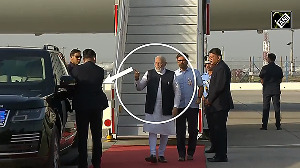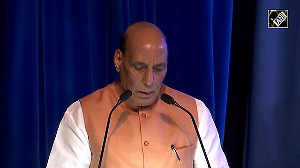As the year 2006 comes to an end, it is time to check how the stock market has performed, and what sectors and companies have rewarded investors. At first blush, the numbers are impressive.
The 30-share large-cap Sensex has gained 43 per cent from the beginning of the year till December 22. These numbers compare favourably to the Sensex gains of 42 per cent in 2005, 13 per cent in 2004 and 73 per cent in 2003.
However as the index becomes more broad-based, the returns keep tapering off. For example, the returns of the 50-stock Nifty stood at a lower 36.5 per cent. Similarly is the case with BSE 100 and BSE 500.
From the performance of the indices, we can construe that the market took a preference to large-cap stocks, and the mid-cap and small-cap stocks didn't do as well in the year 2006.
At the stock level, this conclusion is confirmed. Of the 2600-odd companies, traded on the BSE, about 50 per cent have ended the year in the negative! Of the remaining companies, about half the companies have underperformed the Sensex returns. Thus, only 25 per cent of India Inc delivered Sensex-beating returns in 2006.
Between January and May 2006, the stock markets saw a broad-based rally. Till May 10, the Sensex and BSE 500 was up 34 per cent each. But since then, investors" preference shifted to large-caps, thanks to the meltdown.
During the year, the sectors that have underperformed the Sensex include auto and auto ancillaries, pharma, power, oil and gas, FMCG, sugar, IT, metals, engineering and banks, though there are a few exceptional stocks that did very well in these sectors.
"One of the major reason for large number of stocks underperforming is also the under-performance of the mid-cap stocks with relation to Sensex," says Sandeep Nanda, head-research, Sharekhan. On the other hand, sectors like cement, construction, real estate and hotels have out-performed the key index.
Thus, the year 2006 was a historic period for the Indian stock market - the Sensex closed at 9397 points on December 30, 2005 and then went on to scale the 14,000-point peak.
But despite these unprecedented levels, not everybody on the street has gained. So what happened during the year? Here is how the top sectors performed.
Hotels
Foreign tourist arrivals in India has been growing at over 20 per cent a year. Between January and October 2006, India registered 3.5 million foreign tourist arrivals, up 14 per cent and set to cross 4 million by the end of the year.
There is a shortage of 27,000 rooms.
Capex plans of leading hotel majors to materialise only by FY09.
Room tariffs went up by 20-60 per cent between April and October 2006. Delhi, Hyderabad and Pune saw one of the highest rise in tariffs, besides Bangalore, which is the most expensive city by room tariffs.
Revenues from food and beverages, which forms about 30 per cent of total revenues, is growing around 20 per cent.
Out-performer: Indian Hotels
Under-performers: EIH, Hotel Leela, Viceroy Hotels
Cement
Demand grew at 8-10 per cent while supply increased by 5 per cent in 2006. Strong demand from the housing, infrastructure, IT/ITES industry, malls and multiplexes. Companies operating at over 95 per cent capacity utilisation.
Overall, cement prices up by 37 per cent. While South and Central region saw biggest rise in prices, North and West each witnessed about 25 per cent rise. East saw a modest growth of 20 per cent.
Major capex for over 50 million tonne announced by players.
After a surplus in FY06, the industry will see a substantial deficit of 2.7 million tonnes in FY07.
Acquisition of major stakes in Indian companies by foreign cement majors. For example Holcim bought stakes in ACC and Gujarat Ambuja. Heidelberg bought a stake in Mysore Cement.
The sector has been a star performer with only 24 per cent of the total cement companies under-performing the index.
Out-performers: Shree Cement, Mangalam Cement, Mysore Cement, UltraTech, India Cements, Madras Cements, ACC, Gujarat Ambuja
Under-performers: Birla Corp, Kakatiya Cements, OCL India, JK Cement, Andhra Cement
Construction and Real estate
Increased government spending on infrastructure and rising housing demand led to bulging order books of companies.
Visibility of earnings improved.
Order book to sales ratio of major companies rose from 3x in FY06 to 3.5-6.5x in October 2006.
Key risks of execution capability, impact of higher interest rates and input costs pressures led to some correction later in the year.
Real estate companies dominated the out-performing pack, thanks to the rising value of their land banks, and overall, only 34 per cent have under-performed.
Out-performers: Unitech, Lok Housing, Ansal Properties, Anant Raj Industries, Era Constructions, Peninsula Land, IVRCL Infrastructure, Ansal Housing, Mahindra Gesco, DS Kulkarni, Jaiprakash Associates, Nagarjuna Construction
Under-performers: PBA Infrastructure, Patel Engineering, HCC, Simplex Infra, Noida Toll Bridge, Gammon
Engineering
Though there were a few stocks that have done exceedingly well, a large proportion of the engineering sector universe was an under-performer.
Most of these stocks corrected sharply in the range of 20-60 per cent in the May market meltdown after touching peak levels prior to that.
Operating margins of many companies declined due to input cost pressures especially in the September quarter.
However, earnings visibility was strong with healthy order books due to increased spending on infrastructure and cost competitiveness of Indian players.
Investment in infrastructure are likely to be $275 billion in various segments over the next five years.
Out-performers: ABB, Siemens, BHEL, Elecon Engineering, AIA Engineering, Alstom Projects, Larsen and Toubro
Under-performers: ABG Heavy Industries, Bharat Earth Movers, Engineers India, Alfa Laval, Sulzer India
Banks
Strong growth in money supply and credit. Advances grew by 30 per cent over two consecutive years and also in H1 FY07.
The key highlights were strong retail growth, strong corporate capex cycle and investment in infrastructure.
Despite that, banks had been scrambling for resources. Deposits are growing by 15-20 per cent.
Improvement in operating efficiencies and non-performing asset levels.
Stable to declining net interest margins especially for public sector banks.
After various monetary policy measures like increasing the weightage on risky assets and the repo rate hike, RBI recently raised cash reserve ratio by 50 basis point from 5 to 5.5 per cent after almost two years.
Pause in interest rate hike by US Fed since August triggered the rally in banking stocks, which were major under-performers for one year prior to that.
Despite the recent rally, still 71 per cent of the banks have under-performed or given negative returns.
Out-performers: Yes Bank, City Union Bank, Kotak Mahindra Bank, UTI Bank, Bank of India, State Bank of India, HDFC Bank, ICICI Bank
Under-performers: Indian Overseas Bank, Canara Bank, Allahabad Bank, Punjab National Bank, Bank of Baroda, Union Bank of India, Oriental Bank of Commerce
FMCG
Almost all the companies reported robust top line growth in double digits.
Rising urban incomes coupled with strong demand in the rural economy due to increasing disposable income.
However, the higher base effect reflected in some categories like shampoos and detergents.
Companies grappling with input cost pressures.
Companies like HLL, Dabur India and Colgate went ahead with price hikes to protect margins
Ad spends on the rise.
This sector, which was an out-performer till May 2006, has been a major under-performer, with the exception of Marico.
Auto and Auto ancillaries
The auto and auto ancillary sector had over 80 per cent as under-performers.
Passenger vehicles have registered a 16.38 per cent y-o-y growth in sales between January and November 2006.
Cars grew at 18.6 per cent and UVs (utility vehicles) at 9 per cent.
Ban on overloading of trucks helped the commercial vehicle segment grow 26 per cent.
Though the growth in the two-wheeler segment has been about 16 per cent, intense competition and input cost pressures affected most two-wheeler stocks.
Except M&M and Maruti, operating margins of others especially two wheelers have been under pressure.
Though top line growth was generally robust, most auto ancillaries faced margin erosion due to higher input costs and pressure to reduce prices from manufacturers.
Out-performers: Eicher Motors, M&M, Sona Koyo, Federal-Mogul
Market performer: Maruti Udyog
Under-performers: Tata Motors, Bajaj Auto, Hero Honda, Ashok Leyland
Metals
Metals have had a roller-coaster rise on the bourses with volatility being the order of the day even as non-ferrous metals (aluminium, copper and zinc) touched their record high levels in May 2006.
While major steel stocks have performed well surprisingly despite the threat of Chinese imports, non-ferrous metal stocks have done even better thanks to spiralling rise in the copper, zinc and aluminium prices.
The global steel industry witnessed consolidation with the merger of two of the world"s top steel producers - Mittal Steel and Arcelor -- to become the largest global steel producer.
Tata Steel made a bid for Corus.
While domestic demand for steel has been strong, China became a net exporter.
After bouncing back in Q4 FY06, international steel prices have been more or less stable.
Out-performers: Hindustan Zinc, Sterlite Industries, SAIL, Bhushan Steel, Madras Aluminium, Kalyani Steel, JSW Steel
Under-performers: Hindlaco, Tata Steel, Jindal Stainless, Jindal Steel and Power, Nalco
Information Technology
Robust demand scenario leading to 30 per cent revenue growth for top-rung companies thanks to the addition of new clients and modest price hikes.
Indian IT companies continue to have an advantage of being cost competitive and talent pool.
Marginal impact of US slowdown, corporate IT spending on the rise.
Dependence on the US--the largest market for IT-- is slowly declining. Growth in Europe has been faster.
However, wage hike of 10-15 per cent and high attrition rates are capping margin expansion.
Both large- and mid-sized companies are acquiring global companies to become competitive. For example NIIT Technologies acquiring ROOM Solutions, UK, and Hexaware bought FocusFrame.
Stocks in this sector have declined less than many other sectors though many under-performers relative to the Sensex.
Out-performers: Infosys, NIIT, NIIT Technologies, Hinduja TMT, Zenith Infotech, i-flex solutions, Mphasis, Sonata Software, Infotech Enterprises, Subex Azure
Under-performers: Satyam, Wipro, TCS, Hexaware, Nucleus Software, Zensar
Pharmaceuticals
Strong growth in the domestic market given the high volume growth on the back of aggressive new product launches and the continued focus of companies in the high growth chronic lifestyle segments.
However, contentious issues of pricing control continues in the domestic market.
Robust export scenario driven by new launches of generics or supplying of active pharmaceutical ingredients to the global generic players.
Indian players garnering larger share in the DMFs filed with the US FDA.
But competition and pricing pressures persist in the key markets of the US and Europe.
Players mitigating pricing pressure abroad by expanding their product basket and stepping up R&D activities.
Many companies shifting production to tax-saving havens like Himachal Pradesh.
Only large-cap and some specific stocks have gained market attention.
Out-performers: Glenmark Pharma, Dr Reddy's, Divi's Laboratories, Lupin, Aurobindo, Elder
Under-performers: Cipla, Ranbaxy, Sun Pharma, Shasun, Matrix Laboratories, Nicholas Piramal
Out-performers and under-performers are vs the Sensex








 © 2025
© 2025